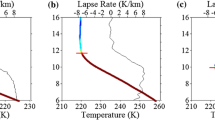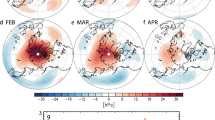Abstract
Some important data on both lunar tidal and solar effects on mesopause region characteristics, which were obtained by scientists of the Obukhov Institute of Atmospheric Physics in cooperation with colleagues from other organizations, are discussed. The present-day evidence that supports the hypothesis proposed by A.I. Semenov and N.N. Shefov about the existence of oscillations (with periods of the lunar synodic month and its half) in the mesopause region characteristics is considered. The oscillation amplitudes are estimated based on a statistical analysis of measurement data, possible mechanisms for generating these oscillations are indicated. Statistical data on the effect of solar activity on the mesopause region are discussed. It is shown that the effects of solar activity on some atmospheric characteristics on interannual and intraseasonal time scales have opposite signs, which suggests that there are different physical mechanisms of solar-terrestrial relations within these frequency ranges.



Similar content being viewed by others
REFERENCES
N. N. Shefov, A. I. Semenov, and V. Yu. Khomich, Radiation of the Upper Atmosphere as an Indicator of its Structure and Dynamics (GEOS, Moscow, 2006) [in Russian].
N. N. Shefov, “Some features of hydroxyl emission,” in Polar Glows and Nocturnal Airglows (Nauka, Moscow, 1967), No. 13, pp. 37–43.
J. Egedal, “The tides of the upper atmosphere and the heights of meteors,” Nature 124 (3137), 913–914 (1929).
A. I. Semenov and N. N. Shefov, “An empirical model for the variations in the hydroxyl emission,” Geomagn. Aeron. (Engl. Transl.) 36 (4) 68–85 (1996).
T. Nagata, T. Tohmatsu, and E. Kaneda, “Lunar time variation of the oxygen green line in the airglow,” Rep. Ionos. Space Res. Jpn. 15 (2), 253–262 (1961).
J. Glaume, “Influence des marées lunaires sur l'émission de la raie verte 5577Å de l’oxygène,” C. R. Acad. Sci. 254 (19), 3399–3401 (1962).
T. Tohmatsu and T. Nagata, “Dynamical studies of the oxygen green line in the airglow,” Planet. Space Sci. 10, 103–116 (1963).
G. B. Pokrovskii and G. M. Teptin, “Lunar tides in the upper atmosphere according to radio meteor observations,” Astron. Tsirk., No. 597, 5–7 (1970).
N. N. Shefov, “Lunar variations in the hydroxyl emission,” Geomagn. Aeron. 14 (5), 920–922 (1974).
N. N. Shefov, “Lunar tidal variations of hydroxyl emission,” Ind. J. Radio Space Phys. 3 (13), 313–314 (1974).
E. P. Kropotkina and N. N. Shefov, “Influence of lunar tides on the probability of emergence of noctilucent clouds,” Izv. Akad. Nauk SSSR: Fiz. Atmos. Okeana 11 (11), 1184–1186 (1975).
A. T. Doodson, “The harmonic development of tide-generating potential,” Proc. R. Soc. London, Ser. A 100, 305–329 (1921).
J. Scheer and E. R. Reisin, “Rotational temperatures for OH and O2 airglow bands measured simultaneously from El Leoncito (31°48'),” J. Atmos. Terr. Phys. 52 (1), 47–57 (1990).
N. N. Pertsev, P. A. Dalin, and V. I. Perminov, “Influence of semidiurnal and semimonthly lunar tides on the mesopause as observed in hydroxyl layer and noctilucent clouds characteristics,” Geomagn. Aeron. (Engl. Transl.) 55 (6), 811–820 (2015). https://doi.org/10.1134/S0016793215060109
P. Dalin, S. Kirkwood, N. Pertsev, and V. Perminov, “Influence of solar and lunar tides on the mesopause region as observed in polar mesosphere summer echoes characteristics,” J. Geophys. Res.: Atmos. 122 (19), 10369–10383 (2017). https://doi.org/10.1002/2017JD026509
I. S. Astapovich, Meteor Phenomena in the Earth’s Atmosphere (Gos. izd. fiz.–mat. lit., 1958) [in Russian].
S. F. Rodionov, E. N. Pavlova, E. D. Sholokhova, et al., “Annual course of night sky IR radiation,” Dokl. Akad. Nauk SSSR 98 (6), 957 (1954).
O. V. Vasil’ev, Astrophysical Studies of Noctilucent Clouds (Izd. Astrosoveta AN SSSR, Moscow, 1967) [in Russian].
N. N. Shefov, “Behavior of hydroxyl emission during solar cycles, seasons, and geomagnetic disturbances” in Aurorae and Airglow (Nauka, Moscow, 1973), No. 20, pp. 23–39 [in Russian].
A. N. Gruzdev, H. Schmidt, and G. P. Brasseur, “The effect of the solar rotational irradiance variation on the middle and upper atmosphere calculated by a three-dimensional chemistry–climate model,” Atmos. Chem. Phys. 9, 595–614 (2009).
http://lasp.colorado.edu/data/timed_see/composite_ lya/version3/.
P. Dalin, S. Kirkwood, H. Andersen, O. Hansen, N. Pertsev, and V. Romejko, “Comparison of long-term Moscow and Danish NLC observations: Statistical results,” Ann. Geophys. 24, 2841–2849 (2006).
C. E. Robert, C. von Savigny, N. Rahpoe, H. Bovensmann, J. P. Burrows, M. T. DeLand, and M. J. Schwartz, “First evidence of a 27 day solar signature in noctilucent cloud occurrence frequency,” J. Geophys. Res. 115, D00I12 (2010). https://doi.org/10.1029/2009JD012359
P. Dalin, N. Pertsev, V. Perminov, A. Dubietis, A. Zadorozhny, M. Zalcik, I. McEachran, T. McEwan, K. Černis, J. Gronne, T. Taustrup, O. Hansen, H. Andersen, D. Melnikov, A. Manevich, et al., “Response of noctilucent cloud brightness to daily solar variations,” J. Atmos. Sol.-Terr. Phys. 169, 83–90 (2018). https://doi.org/10.1016/j.jastp.2018.01.025
B. G. Shpynev, A. V. Oinats, V. P. Lebedev, M. A. Chernigovskaya, I. I. Orlov, A. Yu. Belinskaya, and O. M. Grekhov, “Manifestation of gravitational tides and planetary waves in long-term variations in geophysical parameters,” Geomagn. Aeron. (Engl. Transl.) 54 (4), 500–512 (2014).
P. Dalin, V. Perminov, N. Pertsev, and V. Romejko, “Updated long-term trends in mesopause temperature, airglow emissions, and noctilucent clouds,” J. Geophys. Res.: Atmos., 125, e2019JD030814 (2020). https://doi.org/10.1029/2019JD030814
V. I. Perminov, N. N. Pertsev, P. A. Dalin, Yu. A. Zheleznov, V. A. Sukhodoev, and M. D. Orekhov, “Seasonal and long-term changes in the intensity of O2(b1Σ) and OH(X2Π) airglow in the mesopause region,” Geomagn. Aeron. (Engl. Transl.) 61 (4), 589–599 (2021).https://doi.org/10.1134/S0016793221040113
O. Lednyts’kyy, C. von Savigny, and M. Weber, “Sensitivity of equatorial atomic oxygen in the MLT region to the 11-year and 27-day solar cycles,” J. Atmos. Sol.-Terr. Phys. 162, 136–150 (2017).
Author information
Authors and Affiliations
Corresponding authors
Ethics declarations
The authors declare that they have no conflict of interest.
Additional information
Translated by B. Dribinskaya
This paper was prepared based on an oral report presented at the All-Russian Conference “Airglow, Structure, and Dynamics of the Middle and Upper Atmosphere” (Moscow, November 22 and 23, 2021).
Rights and permissions
About this article
Cite this article
Pertsev, N.N., Perminov, V.I. & Dalin, P.A. Variations in Mesopause Region Characteristics: Space-Factor Effects. Izv. Atmos. Ocean. Phys. 58, 406–411 (2022). https://doi.org/10.1134/S0001433822040119
Received:
Revised:
Accepted:
Published:
Issue Date:
DOI: https://doi.org/10.1134/S0001433822040119




